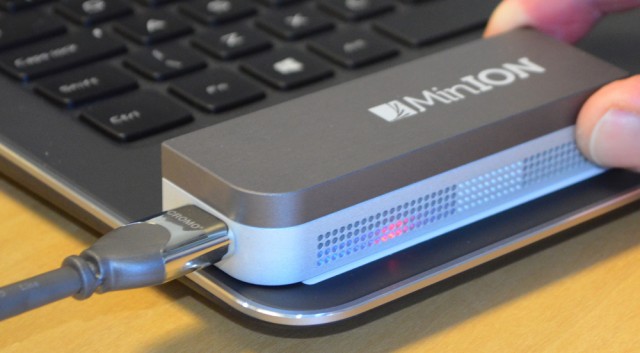When it comes to DNA, France has always been behind the times. Never mind the hefty fines and prison sentence a man apparently can get for trying to order a paternity test, it seems that just knowing your own genetic sequence is offensive enough. Now that the much anticipated MinION USB stick genome sequencer has finally been rolled out, it’s going to be a whole lot tougher for the gene police.
The MinION took a little longer than we originally reported. Even now the 4-inch USB stick has only been made available to select labs Oxford Nanopore has chosen to let purchase the device. Early reports suggest that the MinION will indeed be all that it had originally claimed — namely, have the ability to sequence long reads (i.e. 80,000 base letters long) and up to 150 million bases in six hours. The main concern now is its accuracy.
The MinION USB gene sequencer, plugged into a laptop
Some researchers are claiming that they are only getting about 65 to 80% accuracy out of the device. Fortunately for the French citizenry, if only a limited percentage of genome report is correct you could probably make the case that you don’t really know your DNA. The key to getting reliable reads from unreliable nanopore readers is simple redundancy. Provided the sequencing errors are not significantly correlated, and the sequencing can be perpetuated without performance decay, then in theory any arbitrary degree of accuracy can be attained.
Read: Harvard cracks DNA storage, crams 700 terabytes of data into a single gram
The ability to pipette a bit of bodily fluid onto a device and have DNA sequences appear on you screen in front of you may feel like the ultimate conquest of nature, but many may be wondering what good it is to have such a device if your genome has already been sequenced before. The answer is it hasn’t. Unless you were sequenced as an egg, then any sequence you may have been given is just a minor subset of the full DNA spec that has become you. Many people are natural mosaics that formed early on in pregnancy by mysterious union or division of ambivalent agglomerations of cells. Since that time the cells in different organs and tissues have accumulated vast genetic differences through natural and/or directed mutation processes.
This doesn’t even begin to account for all our DNA heterogeneity, though. In addition to possessing thousands of mitochondria per cell with their own related, but still personal DNA stashes, there is the vastly larger pool of endosymbionts — organisms that live inside other cells or creatures — that contribute immeasurably to our being. This larger pool of bacterial, viral, and even free DNA is what now has come to be known as the hologenome. Access to the hologenome, and to changes in our DNA in different tissues over time promises to be the most valuable weapon against present and future disease. While competing devices may be waiting in the wings, the MinION is the tool now best poised to bring us into that world.
Read: Gene therapy comes of age: We can now edit entire genomes to cure diseases
A final, cutting-edge new example highlights just how far some cells, and creatures, go to reconfigure their original “genome” throughout their lives. Every time a bizarre organismknown as Oxytricha trifallax has a sexual encounter, it decrypts its own DNA and builds an entirely new version together with its partner. Strangely, there is no actual reproduction involved in these encounters, just exchange of DNA. Such extreme genetic rewiring is now just beginning to be witnessed, much less understood.
The eventual mass-market price of the MinION gene sequencer still isn’t known. It will hopefully be under $1,000, though, which in the world of gene sequencing is pretty darn cheap.
Source: http://www.extremetech.com/extreme/190409-minion-usb-stick-gene-sequencer-finally-comes-to-market



